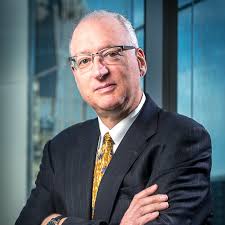David: “How do you train lawyers?”
Lawyers: “Huh?”
David: “How do you train pigeons?”
 Then he drew a box. The pigeon is at one corner of the box. You want to get the pigeon to move to the opposite end of the box. (The X marks the spot.) You have food pellets to use as a motivator. Where do you place the pellets?
Then he drew a box. The pigeon is at one corner of the box. You want to get the pigeon to move to the opposite end of the box. (The X marks the spot.) You have food pellets to use as a motivator. Where do you place the pellets?
The answer, of course, was not to place the first pellet at the ultimate goal but to place it a few inches from the pigeon. Then a few inches further, and so on and so forth, until it finally reaches the opposite end of the box.
The first question I asked myself is why the lawyers in the room weren’t more insulted by the comparison — must have been something in David’s style. Putting that aside, I drew two lessons from the analogy.
The first, more obvious point, is the need to meet people where they are and move in small steps. The second, more interesting point, is the embedded assumption in the analogy: that someone knows where we want Pigeon, Esq. to end up, and can place the real-world equivalent of food pellets in a neat path toward that destination.
For us at Seyfarth, real life turned out to be a bit more complicated than a box, and our path has been neither neat nor linear. In fact, our journey has led us to some places we would never have predicted. Because there is nothing neat or linear about the journey, the trick is how to make the elephant dance; that is, how can we be more agile and adaptive to the lessons we learn along the way?
Vision requires finding your own X
I think part of the problem with the lack of change in our industry is that there is no clear corner to the box. In fact, let’s be really honest: there is no box. In the real world, there is no destination marked with a bright red X. Change is not a trip to the mall, where kiosks display helpful maps with a green dot that says: “you are HERE.”
 The staid days of methodically training a workforce to adopt widely-accepted “best practices” are long gone. There’s no change manual, no set of step-by-step instructions that will get you from where you are now to a pre-defined destination that is objectively “better.” In this environment, each organization must take upon itself the emotionally arduous task of defining for itself where it stands today (“you are HERE”) and where it wants to be in the future (“X marks the spot”). How do we do this?
The staid days of methodically training a workforce to adopt widely-accepted “best practices” are long gone. There’s no change manual, no set of step-by-step instructions that will get you from where you are now to a pre-defined destination that is objectively “better.” In this environment, each organization must take upon itself the emotionally arduous task of defining for itself where it stands today (“you are HERE”) and where it wants to be in the future (“X marks the spot”). How do we do this?
As a first step, I suggest putting our hubris aside. I routinely hear firms announce that they only perform “premium” or “bespoke” legal services. This simply cannot be true — at least on the scale that I hear it articulated. Be honest about who and what you are as an organization — so you can envision an aspirational future that is true to that identity. Be honest about what you are doing well and be brutally honest what you should be doing better. Be especially honest about what you can actually do “best.” Vague delusions about becoming “the best” aren’t helpful; in fact, they’re harmful to your cause. Imitation may be the sincerest form of flattery, but it makes for a poor inner compass.
On the other hand, don’t sell yourself short. As the noted philosopher, Taylor Swift wrote in a Wall Street Journal op-ed: “Music is art, and art is important and rare… I hope they [artists] don’t underestimate themselves or undervalue their art.” Ms. Swift is absolutely right.
Hold yourself to a higher standard and be specific about what you are trying to improve — both within the context of your status quo and within the context of what clients need now and in the future.
Take yourself out of the echo chamber of rankings and league tables and what they tell you about being “the best.”
Rather than a myopic focus on the points of parity that are celebrated by a faceless crowd, focus on the points of differentiation that are (a) unique to your organization and (b) important to your clients.
It is a group journey, not a solo hike
From the outset, the vision should be to deliver better legal services — not better from the perspective of the lawyers delivering the services but better from the perspective of the clients paying for those services.
Shifting the focal point from “better lawyers” (a firm-centered view) to “better services” (the client-centered view) leads to a critical realization: legal excellence is critical but, standing alone, is insufficient for the delivery of excellent legal services.
Legal excellence is an essential part of the equation to stay competitive, but the answer isn’t solely “even better lawyers” or “more great lawyers.” Yes, we need great lawyers, but escaping the sea of sameness means going beyond that level — and to find points of differentiation, our industry needs to step up our game in the “service” and “delivery” aspects. For the core group leading Seyfarth, this moment of realization was critical — and we assumed that we would transmit a similar burst of energy and inspiration to the entire organization by simply telling them about it. That assumption turned out not to be correct.
As we worked with teams over time, we learned a lot about the art of motivating change. Here are four lessons we learned (some more painfully than others):
1. Consistency is key
What we found early on was that the things that we found motivating did not necessarily motivate others on our teams. Therefore, creating and communicating a vision that resonates deeply enough to spur action is a challenge we take on each and every day. We need to think about the things that motivate people: the impact they want to have on our clients or the firm or our communities or each other, among other things. Southwest Airlines, for example, talks about their mission of providing their customers with “freedom.” It is not internal to the airline, it is about their customers. Whatever your message may be it, of course, needs to be delivered at high-visibility moments. But, it also needs to be underpinned and supported by messages that are delivered every day about the organization’s priorities.
2. Dialogue is necessary
Communication is a two-way street, so solicit feedback often and listen to what you are being told. One of the core tools of Lean SixSigma is Kaizen sessions — the multi-disciplinary continuous improvement sessions. They provide us with invaluable information. Whether you follow that type of structure or not, it is only by listening that an organization can remain flexible and agile when course correction becomes necessary.
Empower your team members by providing the opportunity to participate in shaping the organization’s journey — and watch as they transform into powerful advocates and champions that drive organizational progress.
3. Time, space, and scale all matter — if you can connect the dots
Strike a balance between the challenges immediately before the organization and a bigger vision for where the organization is headed. Address the impact on immediate stakeholders within the organization as well as the potential impact on a larger ecosystem — whether it’s your clients or the profession and industry at large. People not only need to see and understand the larger picture; they also need to see themselves within it.
4. A choir is better than a solo
Find other voices to support your own. Some of the most powerful voices we had, in fact, came from our clients. It was those voices that resonated most strongly with our lawyers. A little luck helps as well; as the industry has embraced the “innovation” mantra, we found ourselves a few years ahead. As industry groups hand out awards and accolades for innovation, we’ve won our fair share — and this in turn helped us validate our path with our teams.
My colleague, Lisa Damon, is fond of saying “you have to meet people where they are.” Absolutely right. People start their journey from different places — you have to accept that fact. The trick is to get them to move forward as a team, even if the end destination is less than clear. When that begins to happen, it becomes a powerful force.
When that begins to happen, it becomes a powerful force.



Leave a Reply